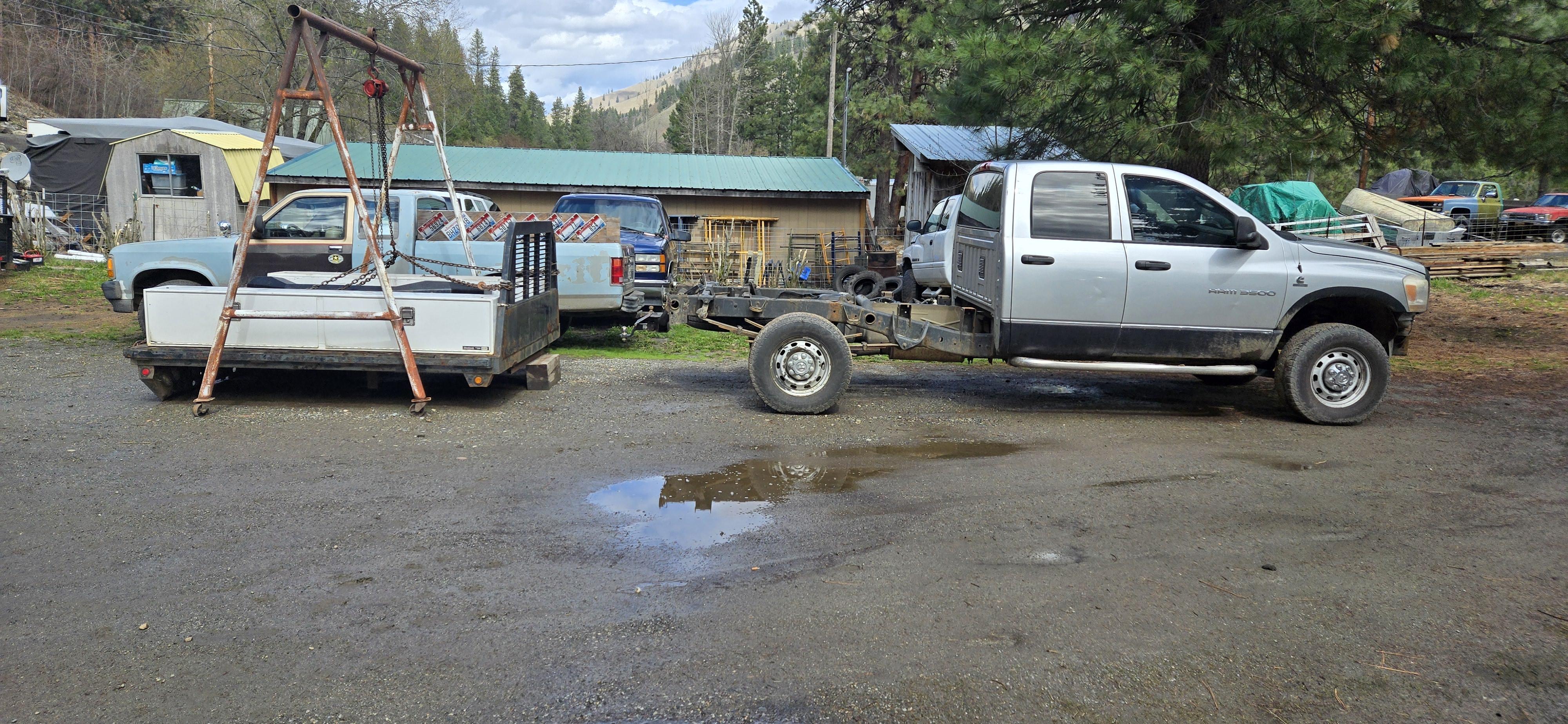How to rebuild a 2nd Gen Power Steering Gear Box
This How-To is for replacing all the seals in the gear box.
For Steering Gear adjustment go here: Steering Gear Adjustment
For just replacing the pitman shaft seal. All you have to do are steps “pitman shaft disassembly” & “pitman shaft assembly”.
For replacing only the input shaft seal. There are multiple ways of skinning this cat, you can pull the old one out with a couple scews. Or you can slide the rotary valve assembly out enough to pull the front section off to replace the seal… Either way, it’s straight forward, though I would recommend either watching some videos, or reading a write-up first just so you know what you’re working with.
If your box is as dirty as mine, I would suggest at least pulling the pitman arm and the piston out to clean everything up, you should be able to reuse the seals if need be.
A couple Notes, Tips, and Tricks:
Before we go and get our hands dirty. First, we’ll have to, well, get our hands dirty. Your first step should be to clean the living day lights out of the power steering gear box. This is a messy job and so any dirt or debris on the outside, will likely end up on the inside. Note, any dirt or debris on the inside will stay on the inside; it’s just the nature of this job.
Get yourself a large clean area to work in. Preferably somewhere if you drop a small ball bearing, you’ll be able to find it.
Get some small containers to hold various parts, along with a bunch of rags.
Once you start to take it apart DO NOT spin the input shaft any more then necessary. If you go too far, there are little balls that will not only fall out of there guides, but also get jammed and prevent you from being able to take it apart.
There are a lot of shims and seals, take note on how everything comes apart. So you can put it back in the same orientation as it came apart. Try and place things on the workbench in a way to make it easier to remember.
Before removing a seal, make sure you have a new one in your rebuild kit, also make sure to lube each seal before installing it, along with any moving parts. When lubing seals and O-rings, it is best to dip them, you don’t want to stretch them out if you rub the oil onto them.
Pitman Shaft Disassembly
Here it sits, unsuspecting and unawares.
1. Take out the (4) 9/16” bolts holding the top cover on, along with the over center adjustment locknut. Now pull up on the cover, (you can also push in on the pitman arm, using a hammer to tap if necessary).

2. Now spin the cover 180* degrees, you should be able to see the teeth on the pitman arm shaft, there are 3 teeth in total. Center them in the hole so you can pull the pitman arm up through the top


3. Take your screwdriver and remove the first pitman shaft seal
http://s20.postimg.org/i66fhigkt/PS_Gear_052.jpg
4. Then take the snap ring out and then other pitman shaft seal, along with the washers. Make note of every things orientation.


Piston Disassembly
5. Now move to the back of the box, there is a snap ring holding the plug in the end, remove it. To do so, there is a hole on the outside you can put a punch into to dislodge the snap ring.


6. To push the plug out, turn the input shaft all to the left. Do not go any further then needed, and do not turn it back to the right.

7. Get ready for the piston to come out, which means having a clear work area encase any balls fall out, along with a container to put them all in. Once ready, then continue to turn the input shaft to the left. The piston will then come out of the housing, once turning the input shaft doesn’t push it out any further. Continue to push/pull the piston out by hand. Be sure to come straight out, as it likes to bind. 

8. Now remove the two strap bolts, along with the tube, be ready for some balls to come out.

9. Put the piston in the vice with some wood blocks or rags to protect it, and remove the 1” hex plug.
Rotary Valve Disassembly
10. Now remove the adjuster lock nut with a punch, and then the adjuster plug with a spanner wrench.


11. To remove the input shaft and rotary valve assembly from the housing, pull on the input shaft, you may need to (using a soft punch or block of wood) tap on the worm shaft within the housing to help get it out. There are some washers, and a pancake bearing that go on the worm shaft, be sure to make note of the orientation.


12. Clean everything up as good as possible before taking apart the rotary valve.
13. To replace the input shaft seal, the front part should slip right off the input shaft. Use a screwdriver to pry the old seal out, and use a socket of the right size to press the new seal back in. Dip the seal in PS fluid before installation.


14. To take apart the rotary valve remove the brown O-ring on the end, and tap the input shaft in, it should come apart.


15. Take note how it comes apart.
16. Clean the crap out of everything.
Input Shaft Assembly
17. Remove the Teflon seals, and the O-rings underneath them on the rotary valve.

18. Take the new Teflon ones and boil them in water for 5-10 minutes, dry them, dip them in PS fluid, then reinstall. Try not to twist, or stretch them anymore then you have to.


19. Reassemble. There is a peg in the input shaft, and a hole in the rotary valve that must go together (1st pic). And a slot and peg that must go together in the 2nd pic (peg not shown).


20. Now press the whole assembly into the housing, do not press on the input shaft.

Piston Assembly
21. After cleaning everything, replace the Teflon seal like you did the others; boil it in water for 5-10 minutes, dry, then lube. Try not to stretch or twist it more then necessary.
22. The part you’ve been waiting for! Working with all them little balls! Clean them all up, and sort them. Half of them are shiny chrome looking, and half are a duller steel. (there is still a dull one in the chrome bin in the picture).

23. OK, now there is a couple ways of doing this, you can either buy the special tool, use a lot of bearing grease and hope the balls stick to the piston walls. Or make your own tool for the job… You may be able to find something that will work, it just has to keep the balls pressed to the outside, and be able to slip out when you install the piston.
24. Now install your special tool into the housing, make sure to push it in from the side with the O-ring. Start by pushing the ball bearings in. You want to alternate between shinny and dull. I like to drop on down the hole, then push it in a little ways with a punch, and then the next one. While saying “Chrome…. Dull…. Chrome….. Dull” to help remember which one I just did. I also think it’s a good idea to give them a little coat of grease as well.
25. You want to keep pushing them in the piston till you have 3 of each color let, 6 total. Then block the ends of the tube with a dab of grease, and put the balls in place. Remember to keep the alternating pattern going, and remember to install it the correct way to make the alternating pattern match what’s in the piston already.
Picture is wrong, should be 6 not 4, makes life easier.
26. Put the two halves of the tubes together, set them in place, might take a little tap from a hammer to get them to sit correctly, and then install the straps down and you’re set. IIRC, you’re supposed to tighten the bolts to 4 ftlb’s.


27. OK, now with the worm gear already in the housing, push the piston into it’s final home, make sure your tool stays pushed up against the worm shaft, while you turning the worm shaft to the right (pull the piston in). Doing so will make it so while you push the piston in, the balls that a being kept in place by your special tool, will slip over the worm shaft into there final home.


Pitman Shaft Assembly
28. Dip all the seals in PS fluid, and install, make sure to go in square, and don’t forget the snap ring in-between.


29. Now wrap the pitman shaft in one layer of electrical tape, to protect your new seals. And push it in from the top, ensure the piston teeth are centered in the housing.


30. Install the top cover with the lip of the rubber seal facing the cover, and bolt it down.


31. Put the 1” hex plug back in the back of the piston.
32. Install the O-ring for the big housing plug, along with the plug and the snap-ring, make sure to put the ends of the snap ring near the hole you used to get it out with, just so the next person doesn’t have to fight it.
The instructions that came with my gates kit, were crap, so I thought I would make my own. Anything I should add or change, let me know.






There are no reviews to display.